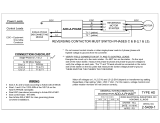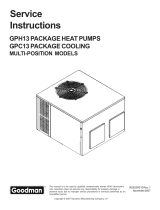Page is loading ...

RONK ELECTRICAL INDUSTRIES, INC. PH: (217) 563-8333 MAN3081
ADD-A-PHASE®
TYPE HE-AA/AA-HE
DESCRIPTION OF OPERATING CHARACTERISTICS
The Automatic Adjusting ADD-A-PHASE is designed to handle the unique operating characteristics of
hydraulic pump motors. The Type HE-AA is for hydraulic elevator applications, and the Type AA-HE
is for hydraulic balers and compactors. The hydraulic pumps used in these applications generally put
their motors under variable loads. These converters have an automatic adjusting circuit board which
senses load and adjusts the current output (for better current balance to the motor) under these
varying load conditions.
CONVERTER OPERATION
STARTING THE MOTOR – A start contactor brings in a set of electrolytic type capacitors that supply
the “manufactured” (“A”) phase’s starting current, which accelerates the motor to its operating speed.
1. A current transformer (C.T.) is used (on the “C” phase) to detect current being drawn by the
motor. Recognition of this condition by the Auto Adjust circuit board initiates the converter’s
motor start sequence. The auxiliary relay closes. Its closing makes the start contactor close.
This connects a bank of start (electrolytic) capacitors to the motor, developing the starting
current needed to accelerate the motor.
2. The duration of the start sequence is normally very short, two seconds or less. A voltage
sensing relay (control relay) will sense a rise in the A-C phase voltage. This rise will occur as
the motor comes to speed. The control relay will de-energize the start contactor. This
removes the start capacitors from the circuit.
RUNNING THE MOTOR – The autotransformer and run capacitors develop running current for the
“A” phase. Changing the capacitance or the taps on the autotransformer will change the currents to
the motor. See the Balancing instructions for further information on balancing. Note: Most AA units
do not require balancing.
1. Two banks of run capacitors provide running current to the motor for the (“A”) phase. The
main bank is always connected and supplies the normal operating current. The run assist
bank is connected through a contactor controlled by the Auto Adjust circuit board. It is brought
into the circuit during motor starts and when high load conditions exist. The number of
capacitors connected and the MFD rating of the capacitors determines the manufactured
phase’s current output to the motor. Capacitors for the 208 and 240 V output units are
connected in parallel, while the 480 V output units are series pairs connected in parallel.
2. Some motors, depending on their power factor (P.F.) may require changing to a different tap of
the autotransformer to achieve better current balance among the three phases.
RUN ASSIST – The Auto Adjust circuit board, unique to the Automatic Adjust ADD-A-PHASE units,
constantly monitors the operating load on the motor (by detecting the amperage on the “C” phase).
When the board senses a significant increase in motor load, additional run capacitance is added to

RONK ELECTRICAL INDUSTRIES, INC. PH: (217) 563-8333 MAN3081
the circuit by the run assist contactor. This increases the manufactured phase’s current output to
match the motor’s higher load condition.
1. When high load conditions are sensed by the board, the run assist contactor is energized,
adding the run assist capacitors in parallel with the main bank of run capacitors. This
additional capacitance raises the “A” phase current output. The higher “A” phase output helps
balance the currents when the motor operates under higher load conditions.
2. When the load conditions are reduced, the circuit board will de-energize the run assist
contactor. This removes the run assist capacitors from the circuit, which brings the “A” phase
current back down to its normal operating level.
AUTO ADJUST CIRCUIT BOARD
The circuit board performs two different functions. It controls the initiation of the converter’s start
circuit. It also controls the run assist contactor.
CURRENT TRANSFORMER (C.T.) – The C.T., which senses the amount of current in the “C” phase
output wire, provides a signal to the circuit board that is directly proportional to the “C” phase current.
CONTROL CIRCUIT BOARD – The circuit board uses the C.T. signal for its two sensing circuits. The
first circuit senses when the motor is operating, and the second circuit senses the load on the motor.
1. The auxiliary relay that powers the start circuit is energized by the control board when the “C”
phase current rises above 5-10 amps. The auxiliary relay remains energized while the motor
runs. When the motor shuts off, the auxiliary relay is de-energized, which “resets” the start
circuit. An indicating LED, located on the right-hand side of the board, illuminates when the
current is above the auxiliary relay’s “pull in” level.
2. The second function of the circuit board is to control the run assist contactor. The contactor is
energized when the board senses an increase in load above the motor’s normal operating
range. When the board senses that the load has returned to its normal operating range, it will
de-energize the run assist contactor. The “pull-in” and “drop-out” points are preset at the
factory. An indicating LED in the front center of the board is illuminated when the current is
above the “pull-in” level.
ADJUSTMENTS
The potentiometers that set the amperage level where the sensing circuits “pull-in” and “drop-out” are
preset for the expected load conditions at the factory. If load conditions are not as expected, the
board can be adjusted for those conditions with assistance from RONK. Contact RONK before
making any adjustments to the circuit board.
BALANCING
The Auto Adjusting ADD-A-PHASE units generally do not require balancing, but sometimes load
conditions are not as expected and current imbalance is greater than wanted. You will need the
amperage readings (identified “A” (L3), “B” (L2), and “C” (L1) as labeled in the ADD-A-PHASE), serial
number of the ADD-A-PHASE, and motor nameplate information for us to assist you. Use the Data
Recording Sheet provided to record this information. Identify whether the run assist contactor is in or
out (or both). This information is necessary for us to give you immediate assistance with balancing or

RONK ELECTRICAL INDUSTRIES, INC. PH: (217) 563-8333 MAN3081
troubleshooting, and it should be kept for future reference. Proper phase identification is crucial for
determining what needs to be done to improve current balance. Changes in capacitance or tap
adjustments are determined by these phase current relationships. Improper identification of the
phases can result in the balance being made worse. Below are the general effects the adjustments
have on the phases.
1. Changes in capacitance affect “A” phase current. Reducing capacitance reduces “A” phase
current, increasing capacitance raises it. “B” and “C” currents will change as well. Typically,
“B” will come down when “A” does, with “C” coming up. Adding capacitance generally lowers
“C” phase. “B” phase can either rise or fall when adding capacitance.
2. Tap changes affect “B” phase current. Raising the tap should raise “B”, lowering the tap
should lower “B”. However, the tap adjustments also change the voltage applied to the run
capacitors. Raising the tap increases the voltage across the run caps and increases “A” phase
current output. Lowering the tap decreases the voltage across the capacitors, lowering “A”
phase output current. Under most conditions, lowering “B” will raise “C” and raising “B” will
lower “C”.
Current imbalance can also indicate problems other than the initial setup of the ADD-A-PHASE. Call
RONK with the appropriate information recorded, if imbalance is greater than desired.
NOTE: Before attempting to service or balance the unit always disconnect power and
discharge all capacitors.
TROUBLESHOOTING
The following troubleshooting techniques will help you in isolating problems. Record all nameplate
information and any readings taken on the Data Recording Sheet. After making these preliminary
observations, call RONK if you need assistance. Having this information will make it easier for us to
assist you with your problem.
1. Locate and observe the start and run assist indicating LEDs on the circuit board.
2. Observe if the start and run assist contactors, the auxiliary relay, and the start and run assist
indicating LEDs energize during motor start. This is normal. If this occurs, it indicates that the
circuit board is powered up and the sensing circuits are working. If the LEDs are on, but a
contactor or the auxiliary relay does not pick-up, the contactor or relay may have a bad coil.
Contact RONK for assistance if the indicating LEDs do not light up.
3. The start contactor should remain energized until the motor accelerates to nearly full speed.
Be prepared to turn power off if the start contactor does not “drop-out” within 5-10 seconds.
4. Unusual motor noise, chattering of contactors or relays can indicate: excess start capacitance,
magnetic starter coil not on the B-C phase, start contactor failing to energize or drop out,
unusually light load conditions, etc. Call RONK for assistance if these conditions exist and the
cause cannot be readily isolated.
5. Be prepared to monitor the three-phase currents to the motor and measure the phase-to-
phase voltages. This information will usually indicate the source of trouble; overloads, stalled
motor, open fuse, fuse fault, etc. Take the readings for A, B, and C phases, as they are
labeled in the ADD-A-PHASE.

/



